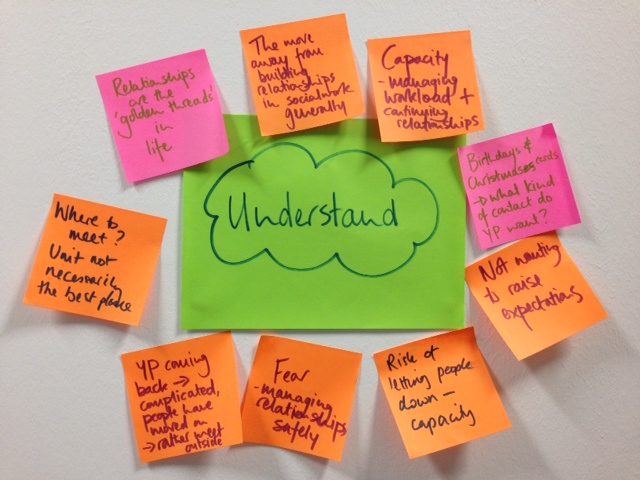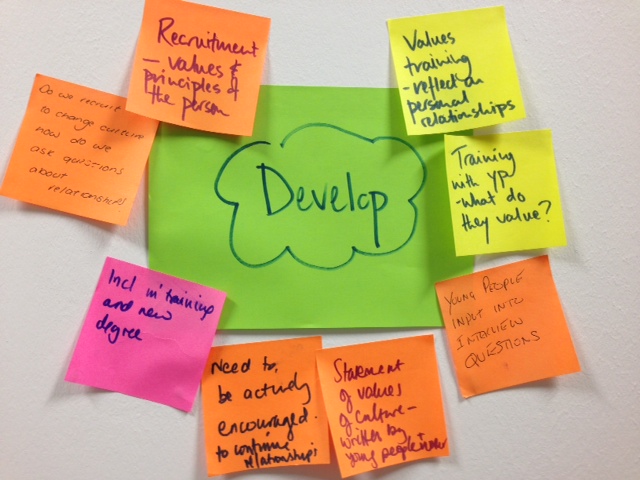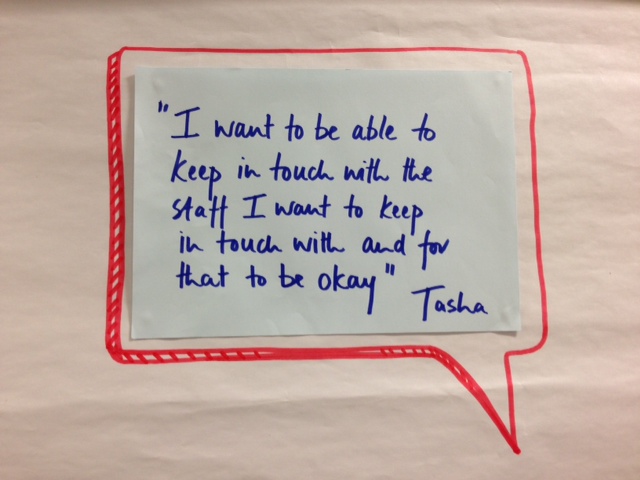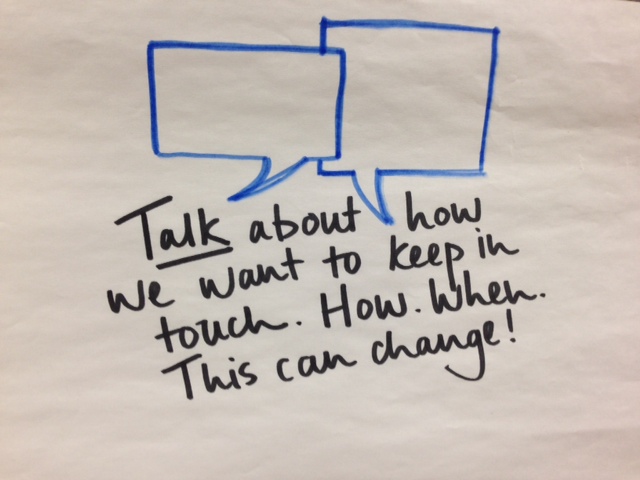Guest blog from Maddy Ross: Facilitator of the Falkirk Council
group.
Needing Permission: Working with Tremanna young people’s home to think about continuing relationships for people leaving care
Understand

We began by thinking about what things would be like if we overcame the barrier that the group had brought to the Jam, and summarised our thoughts with this statement:
“Continuing relationships between young people leaving care and their former workers are natural”
We then talked about everyone’s experiences of where things are now, focusing on the forces that help us to move towards the desired outcome, and the forces that hinder us from doing so.
Some of the ‘Forces that hinder’:
- Uncertainty about what is ok
- Fear of accusations
- Fear that SSSC code of conduct doesn’t permit continued informal relationships
- Capacity and the risk of letting a young person down
- Appropriate venues
- Workers who are only in it for the money
- Needing protocols to manage everything
- Not enough love shown
Some of the ‘Forces that help’:
- Workers that are passionate about what they do
- Culture shift towards seeing continuing relationships as normal/expected
- Support from management to continue relationships
- Tremanna is seen like a family home where people have good relationships, not as a ‘facility’
Keeping the ‘Forces that help’ for the Develop session, we clustered the ‘Forces that hinder’ into themes then voted on them to focus our discussions for the rest of the day. The main theme we chose to focus on was around fear and uncertainty and we spent some more time teasing out details about this before moving into the Develop session.
Develop

In the Develop session, we brainstormed ideas around how to address our themes. Our discussions were beginning to go around in circles a bit when one of the young people from Tremanna spelled out for us what we should be focusing on:
“I want to be able to keep in touch with the staff I want and for that to be ok.”
This helped us to decide that for the rest of the day we’d spend time outlining a basic process for young people and staff who want to keep in touch. No doubt this seems like common sense, but why does it need to be more complicated? Our discussions around the changing attitudes of workers suggested that culture change around continuing relationships was well underway, but until it was fully embedded, some people (both workers and care leavers) would seek explicit ‘permission’, and would appreciate the reassurance of an initial support structure to maintain their relationships.
As part of the Develop session, we also acknowledged a longer-term goal to revise the recruitment process, beginning with a statement of values put together with young people from Tremanna, and ensuring that young people were involved in the interviewing process.
Create
In the Create session we talked about what the key parts of the process would be, and we placed a lot of emphasis on each plan being highly personalised and built on honesty. We talked about whether there should be a document that set out how the young person wanted to stay in touch, as everyone would have their own preferences, but decided just to define a loose process at this stage, which would include the following:
- A commitment from Tremanna to the care leaver that Tremanna would encourage and support the individual to continue the relationships they chose for as long as they chose.
- A series of conversations (probably over several months) between the young person and the person/people they want to keep in touch with to discuss how they want to do this and to talk honestly about what was realistic for both the care leaver and their worker. The worker would let the young person know that they would inform their manager; this was not to seek permission (because you don’t ask your manager to continue a friendship), but so that the young person would know that there was nothing clandestine about the relationship. An initial plan for catch-ups would be put together, which would be more or less formal depending on what the individual wanted. This plan would get revisited and revised as time went on, and perhaps fall away as the relationship developed.
- At supervision, the worker’s manager regularly checks in on how the continuing relationship is going to ensure that the worker is supported.
Share
For the Share part of the day, the team opted to showcase the process to the wider Jam by role-playing some of the conversations they envisioned.
Going forward
Tremanna intend to prototype the plan with a young person who has just secured their own tenancy, and will consider how to encourage the wider workforce to want to be part of continuing relationships through values training.

